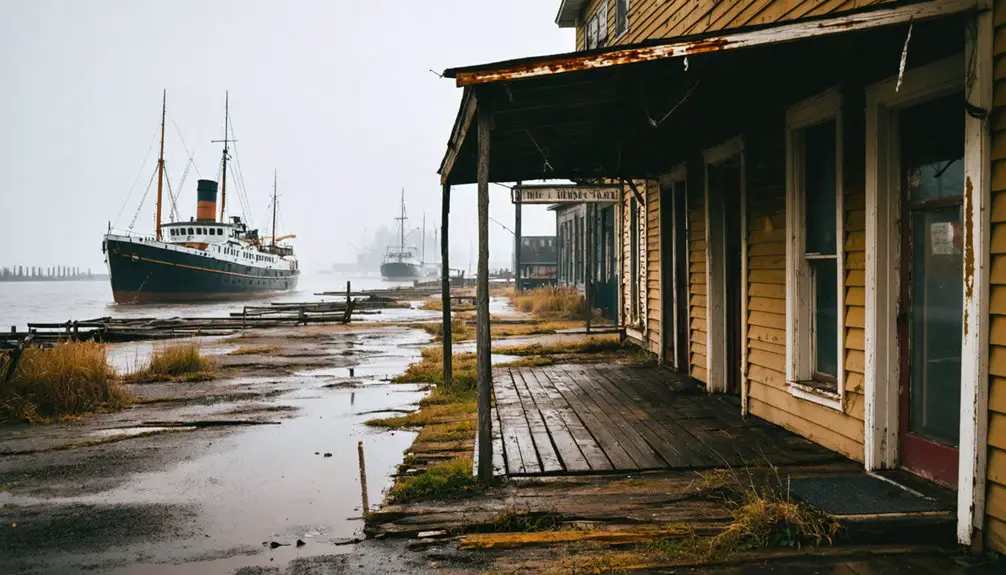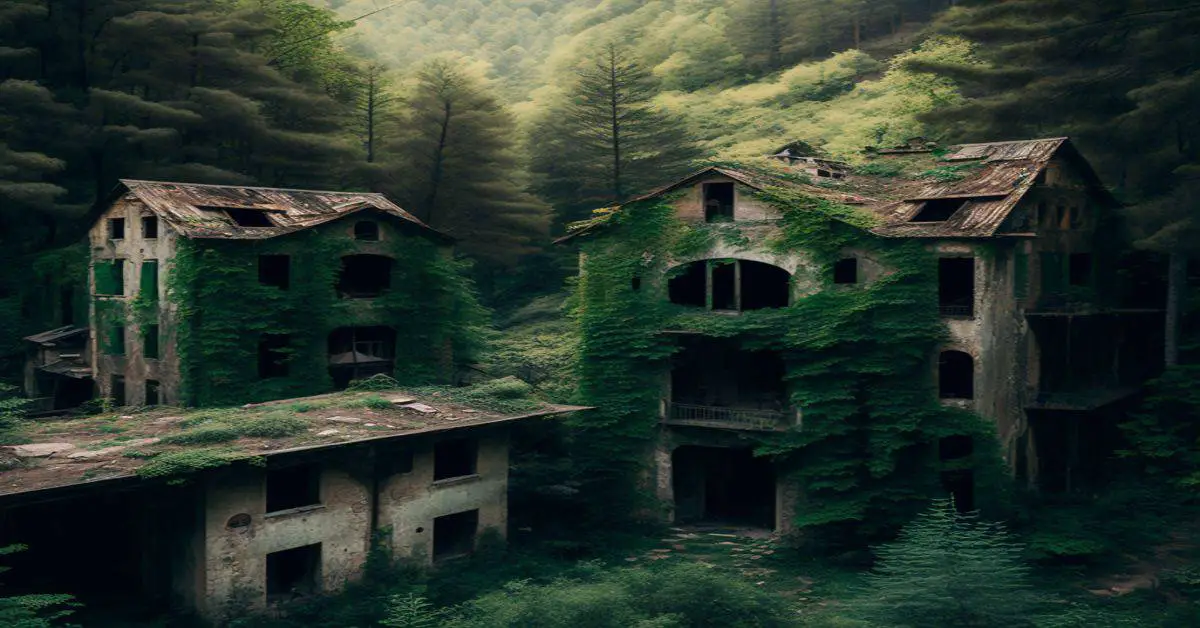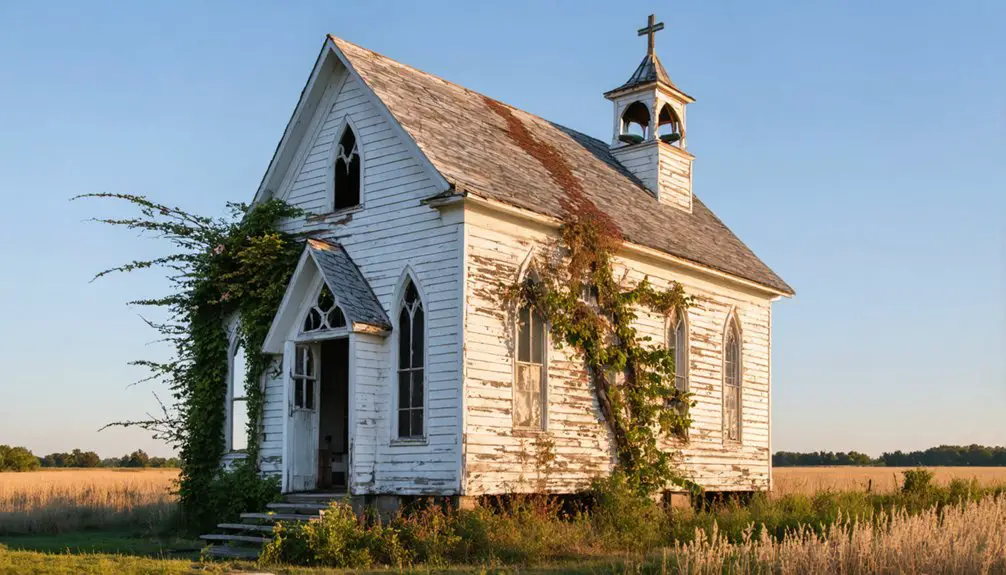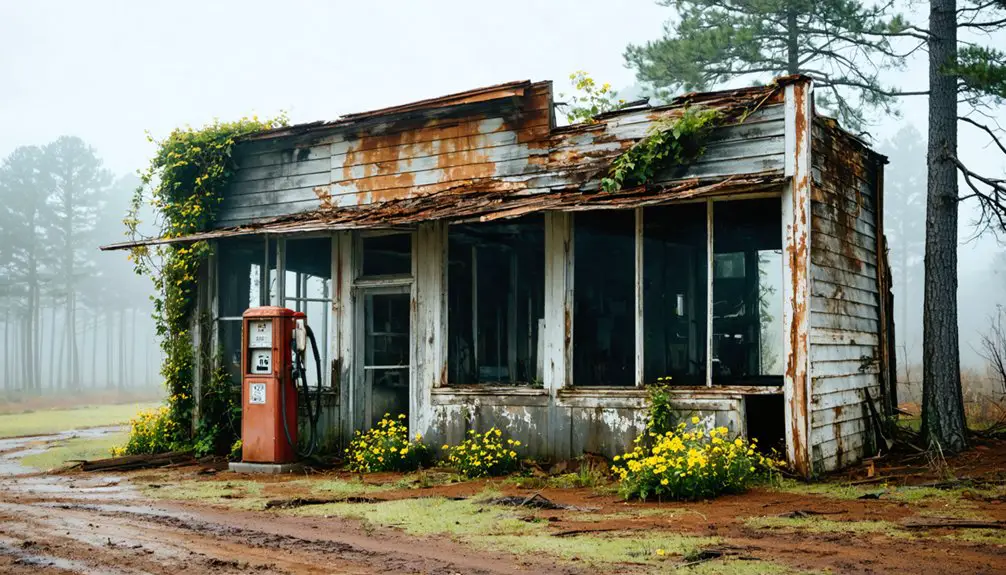You’ll find Old Town (later Rodney) eight miles northwest of Port Gibson, Mississippi, where it once rivaled Natchez as a major cotton shipping port in the 1830s. After surviving Civil War battles that left cannon balls lodged in its Presbyterian Church, the town faced devastating yellow fever epidemics and floods. Today, three historic churches and scattered storefronts stand as silent sentinels, while the mighty Mississippi River that built – and ultimately doomed – this remarkable settlement flows on.
Key Takeaways
- Old Town flourished as a major Mississippi River cotton port in the 1830s with twenty steamboats weekly transporting goods.
- Natural disasters, including yellow fever epidemics and devastating floods between 1843-1935, forced residents to abandon the town.
- The changing course of the Mississippi River contributed significantly to Old Town’s decline and eventual abandonment.
- Historic structures remaining include three churches, Alston’s Grocery, and the Masonic Lodge from the original 35 buildings.
- The ghost town now attracts tourism, particularly during Halloween, with guided tours featuring historical storytelling and architectural remnants.
The Rise of Petit Gulf to Rodney
While indigenous peoples originally used the site as a river crossing, Petit Gulf emerged as an organized town in 1814 along a strategic bend in the Mississippi River.
You’ll find that by the 1820s, the area had transformed into a thriving agricultural hub, with fine farms shipping cotton and deer skins to distant markets.
The town’s significance grew when it received its first formal street survey in 1826, establishing itself as a key shipping point for cotton transport via flatboats to New Orleans.
In 1828, the Mississippi legislature officially renamed the settlement Rodney and drew formal boundaries around its riverfront location. A notable 500-acre land grant was issued to John Campbell in 1772 at what was then known as the Little Gulph.
This change marked a pivotal moment in Petit Gulf history, as the town positioned itself to become a center of agricultural innovation and river commerce. The area became especially renowned after Dr. Rush Nutt developed the Petit Gulf cotton strain in 1833, revolutionizing cotton production in the region.
A Once-Thriving Mississippi River Port
A natural whirlpool formed by a distinctive rock in the Mississippi River marked the strategic location of Old Town, which flourished as a major river port eight miles northwest of Port Gibson.
You’d have found a bustling hub of commerce spread across 80 city blocks, where over twenty steamboats per week transported cotton and goods during the 1830s. Fur trade operations further enhanced the economic vitality of the port. Transportation routes connected through both river and stagecoach lines, serving a thriving population of 1,000 residents.
The town boasted stores, a post office, tavern, hospital, and even a theater. Jewish merchants settled in the area, drawn by the economic opportunities.
But nature had other plans – a devastating tornado in 1853 and the river’s dramatic course change led to economic decline.
Civil War Impacts and Battle Scars
You’ll find Old Town’s most dramatic Civil War episode at the Presbyterian Church, which bore witness to fierce artillery exchanges during the July 1864 Battle of Tupelo.
Union forces transformed the church’s grounds into a defensive position, while Confederate troops under General Forrest launched aggressive assaults from the ridge south of Old Town Creek. Led by Major-General Smith, Union forces managed to repel multiple Confederate attacks from their entrenched position at Harrisburg.
The church’s weathered walls still carried battle scars into the early 1900s, serving as silent testimony to the brutal combat that helped seal the Union’s control over northeast Mississippi’s crucial supply routes. Like many of the approximately 80,000 white Mississippians who served in Confederate forces, local men from Old Town fought desperately to defend their homeland.
During the Civil War‘s fierce struggle for control of the Mississippi River, Old Town found itself at the epicenter of devastating naval confrontations between Union and Confederate forces.
You’ll find evidence of complex naval strategies employed by both sides – from the Confederacy’s cotton-clad rams and shore batteries to the Union’s mortar boats raining destruction from above. The battle transformed the region as Admiral Farragut’s fleet coordinated with Grant’s army to systematically dismantle Confederate defenses. USS Itasca and Pinola broke through the defensive chain barriers, enabling crucial Union advances upriver. The elevated position of Vicksburg’s 129 cannons made naval attacks particularly challenging.
The battle legacies still echo through Old Town’s landscape. Confederate vessels, including the ironclad CSS Louisiana and several cotton-clad rams, met their fate in these waters.
The Union’s victory here proved decisive, severing crucial Confederate supply lines from Texas and Arkansas, while leaving behind sunken vessels and battle-scarred fortifications that would forever alter the area’s character.
Presbyterian Church Battle Legacy
Standing as a representation to Civil War strife, Rodney Presbyterian Church became ground zero for one of the Mississippi River region‘s most dramatic wartime confrontations.
Reverend Baker’s fateful decision to invite Union sailors to worship that day would forever change the course of local history.
The battle strategies employed that September day in 1863 demonstrated the community’s resilience, as Confederate forces successfully captured Union sailors during a Sunday service. Following Vicksburg’s fall, the USS Rattler gunboat maintained a constant presence at Rodney’s port. Today, you’ll find tangible reminders of this pivotal moment in history.
- A replica cannonball remains lodged above the church doors, marking the USS Rattler’s retaliatory strike
- The church walls still bear scars from the naval bombardment
- Local defenders achieved a rare victory by capturing an ironclad gunboat’s crew
- The building’s transfer to the United Daughters of the Confederacy preserved its historical significance
- The church stands as a symbol of divided loyalties during America’s bloodiest conflict
Natural Disasters That Shaped Destiny
You’ll find Rodney’s most devastating natural enemies came in the form of Yellow Fever epidemics in 1843 and 1847, which drove residents to flee and nearly emptied the town.
The Mississippi River’s fury struck repeatedly through catastrophic floods in 1912, 1927, and 1935, with waters reaching the Baptist Church windows and destroying essential infrastructure.
These relentless disasters, coupled with the river’s changing course, sealed Rodney’s fate as residents abandoned hope of sustaining life in such hostile conditions.
Yellow Fever’s Deadly Impact
The devastating yellow fever epidemic of 1878 struck Mississippi with unprecedented force, originating from New Orleans and spreading rapidly northward along the Mississippi River‘s busy trade routes.
You’d have witnessed complete societal collapse as the disease ravaged communities, turning bustling towns into silent graveyards.
- Communities watched helplessly as their leaders, doctors, and law enforcement succumbed to the fever.
- Armed guards enforced strict quarantine lines, restricting your freedom to travel or trade.
- The mosquito-borne illness transformed vibrant settlements into ghost towns as residents fled.
- Towns like Vicksburg lost 1,500 souls, while Greenville’s death toll included most civic leaders.
- Your chances of survival often depended on location – Jackson’s quarantine limited deaths to 80, while Natchez escaped fatalities.
Flood Waters Seal Fate
Nature’s relentless assault through flooding dealt the final devastating blow to Old Town Rodney’s existence, with major inundations recorded in 1912, 1927, 1935, and 2011.
You’ll find evidence of the flooding consequences in the town’s skeletal remains – churches with watermarks reaching their windows, homes perched anxiously on raised pilings, and countless structures washed away by the Mississippi’s fury.
The devastating cycle of community displacement forced your predecessors to abandon their dreams along these shores.
By the 1930s, you’d have witnessed Rodney’s township status revoked as families fled the persistent waters.
Like nearby Prentiss, which now lies beneath the river’s surface, Rodney’s story serves as a stark reminder of the Mississippi’s power to reshape settlements and human destinies alike.
Life Along the Changing River

Along Mississippi’s ever-shifting banks, communities have long wrestled with the river’s natural tendency to carve new paths through the landscape.
You’ll find that river navigation has proven both blessing and curse, as towns rise or face economic decline based on the waterway’s whims.
Historical records show how settlements adapted or vanished as the mighty Mississippi altered course.
- Communities like Vicksburg fought back through ambitious engineering projects
- Trading posts and riverfront markets relocated as channels shifted
- Local harbor committees organized to maintain commercial river access
- Ghost towns emerged where river access disappeared completely
- Families passed down stories of moving entire buildings to follow the water
The river’s changes have shaped not just the physical landscape, but the very fabric of life along its banks, forcing communities to either adapt or fade into history.
Architectural Remnants and Sacred Spaces
Standing as silent sentinels to Rodney’s former grandeur, three historic churches anchor the architectural legacy of this Mississippi ghost town.
You’ll find the 1831 Presbyterian Church, complete with its Civil War cannonball, the 1851 Mt. Zion Baptist Church showcasing Greek and Gothic Revival elements, and the relocated 1868 Sacred Heart Catholic Church in Carpenter Gothic style.
The town’s architectural preservation challenges are evident in the remnants of what was once a bustling commercial district.
Only Alston’s Grocery and the Masonic Lodge survive from the original 35 stores.
Behind the Presbyterian Church, cemetery significance emerges in a three-acre burial ground where roughly 200 graves tell stories of Rodney’s past.
Though many headstones have succumbed to nature, they’re enduring symbols of the town’s rich history.
Tales and Legends of Lost Prosperity
How could a town that nearly became Mississippi’s capital vanish into obscurity? In Rodney’s ghostly whispers, you’ll find a tale of lost fortunes that reads like a Greek tragedy.
Once a thriving river port of 4,000 souls, with Mississippi’s first opera house and flourishing cotton trade, Rodney’s destiny changed through a perfect storm of misfortunes.
From bustling port to forgotten ghost town, Rodney’s story tells how 4,000 dreams crumbled beneath the weight of misfortune.
- Lost the state capital vote by just three votes in 1817, marking the first twist of fate
- Yellow fever epidemics in 1843 and 1847 decimated the population, sending survivors fleeing
- Civil War brought destruction, with Confederate-Union conflicts scarring the Presbyterian Church
- Nature turned against the town as the Mississippi River changed course, leaving Rodney stranded
- Final blow came when the railroad bypassed the town, sealing its economic isolation
Modern Day Ghost Town Tourism
While many abandoned towns fade into obscurity, Rodney’s haunting legacy has found new life through modern ghost tourism.
You’ll discover that ghost tours now attract visitors year-round, with significant spikes during Halloween season. These paranormal experiences blend historical storytelling with technological innovations, as tour guides utilize augmented reality to recreate scenes from the town’s prosperous past.
You’re part of a growing demographic of heritage tourists who value both the supernatural intrigue and historical significance of ghost towns.
Local businesses have flourished from this renewed interest, with nearby hotels and restaurants benefiting from steady visitor traffic.
The preservation of Rodney’s structures relies heavily on tourism revenue, ensuring that future generations can explore these haunting remnants while supporting the regional economy.
Frequently Asked Questions
Are There Any Dangerous Wild Animals in the Abandoned Buildings?
You’ll need to watch for wildlife encounters with venomous snakes, rabid bats, and aggressive feral animals in abandoned buildings. Don’t explore without proper animal safety precautions.
What Happened to the Oakland College Campus Buildings?
Among towering oaks and weathered brick, you’ll find that most Oakland College buildings vanished after 1871, except the majestic Oakland Memorial Chapel, which still stands proudly on Alcorn State’s campus today.
Can Visitors Stay Overnight in Any of Rodney’s Remaining Structures?
You can’t stay overnight in Rodney’s ghostly accommodations, as historic preservation efforts focus on protecting remaining structures. All buildings are unsafe, abandoned, or demolished, with no sanctioned lodging options available.
How Many Graves Remain in the Historic Rodney Cemetery?
While you won’t find perfectly preserved grave markers, Rodney Cemetery contains approximately 200 documented burials, with Find A Grave listing 190 memorials, reflecting centuries of burial history from 1828 onward.
Were Any Movies or Television Shows Filmed in Rodney?
You’ll find limited film history in Rodney, with James Brown’s biopic “Get On Up” (2014) and “Operation Raintree” (1957) being notable productions. Local legends have drawn mostly independent documentaries and ghost town explorers.
References
- https://theforgottensouth.com/rodney-mississippi-ghost-town-history-tour/
- https://mississippifolklife.org/articles/haunted-by-a-ghost-town-the-lure-of-rodney-mississippi
- https://www.onlyinyourstate.com/state-pride/mississippi/lost-town-in-ms
- https://en.wikipedia.org/wiki/Old_Greenville
- https://en.wikipedia.org/wiki/Rodney
- https://en.wikipedia.org/wiki/Petit_Gulf
- http://www.americanyawp.com/text/11-the-cotton-revolution/
- https://human.libretexts.org/Under_Construction/Purgatory/African_American_History_(Lumen)/07:_The_Westward_Expansion_of_Slavery/7.02:_The_Creation_Of_The_Cotton_Kingdom
- https://mississippiencyclopedia.org/entries/cotton/
- https://en.wikipedia.org/wiki/Petit_Gulf_cotton



